Insignia
.
Cap Device
.
| The first pattern of the WWII Army Nurses
visored service cap had a fabric bow at the front and initially was worn
without any insignia. However, some nurses pinned the ANC collar insignia
above the middle of the bow.
The pattern of the service cap was revised
a few months later. The fabric bow at the front was omitted and approval
was given to nurses' requests for the same regulation United States Coat
of Arms on their service caps as male officers wore. |
.v |
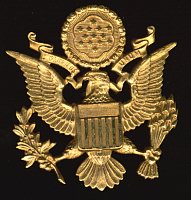 Cap Device: Regulation Coat
of Arms of the United States
Cap Device: Regulation Coat
of Arms of the United States
|
.
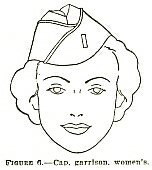 |
.v |
At first, Army Nurses wore their caduceus
collar branch insignia on the left front of their overseas caps.
Later, in 1943, it was ordered to wear a rank
pin only on the left side one inch from the front center of their overseas
caps, thus adopting the same wear authorized for male officers. |
.
Collar Insignia
.
The Army Nurse Corps was part of the Army's
Medical Service Corps. The branch insignia of the Medical Service Corps
consisted of a winged caduceus with two entwined snakes.
.
| A letter was superimposed on the staff of
the caduceus to distinguish special Medical Service Corps of the Army (for
example "D" for Dental Corps, "V" for Veterinary Corps, "S" for Sanitary
Corps, PT for Physical Therapists). A superimposed "N" indicated
the Army Nurse Corps. |
..v |
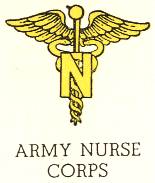 |
.
.

Left: Caduceus with white enameled
N
Middle: Caduceus with brown
enameled N
Right: Caduceus with black N |
..v |
It was very common to use contrasting
coloration on the superimposed letters, in order to highlight the exact
branch of the Medical Service Corps being served. For example, a bronze
and a brown enameled N was already adopted during the 1920s, white and
black during the 1930s. |
.
During World War II, it was permitted to continue
the use of older devices issued in the 1920s and 1930s. The availability
of the different insignia depended on the manufacturer. Slight variations
in design were common as well.
.
The caduceus was worn on both lapels of the
WWII service uniforms.
The cut-out US letters were worn on the collar
of the service uniform.
Rank insignia were attached to the shoulder
loops. |
......... |
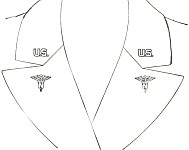
Placement of Insignia
on the Service Uniform
|
| . |
|
|
Additionally, the caduceus was worn on the
left side of the collar on capes, hospital uniforms and shirtwaists (if
the jacket was removed).
A rank pin was worn on the right side of the
collar.
On hospital uniforms where the rank pins could
be worn on shoulder epaulets, the US letters were worn on the right side
of the collar instead of the rank pin. |
|
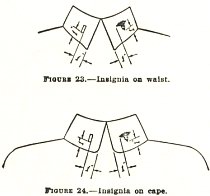 |
| . |
|
|
On the Off-Duty dress, the caduceus
was worn on the left side of the collar, the cut-out US letters on the
right side and rank insignia on the shoulder loops.
The insignia were placed the same way on the
brown and white seersucker uniform when worn with the matching jacket. |
|
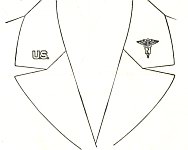
Placement of Insignia
on the Off-Duty Dress
|
.
.
No insignia were worn on the collar and
lapel
of overcoats, raincoats or jackets, field
M1943.
.
Rank Insignia
.
At the beginning of the war, the Army Nurses obtained
relative ranks only. In June 1944, they were granted actual ranks of Army
officers but limited for the duration of the war plus six months. The highest
rank granted was that of colonel, which was held by the superintendent
of the Army Nurse Corps Florence Blanchfield.
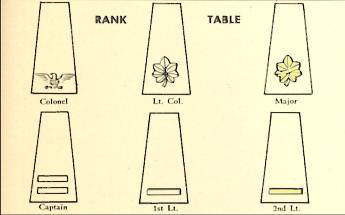
.
Grade Insignia were worn on shoulder loop of the
service jackets as prescribed for male officers of the Army. They were
also worn on the shoulder loop of the off-duty dress, overcoat, utility
coat and the M1941 and M1943 field jacket.
Additionally, the grade insignia were worn
on the right side of the collar on capes and waists (if jacket was removed).
.
Flight Nurse Wings
.
Flight Nurses wore a flight nurse's wing above
their left sleeve pocket. The first flight nurse wing was authorized in
December 1943. The gold color of the first wing version was changed to
silver at the end of 1944.
.
 .
Buttons
.
Buttons
.

Regular gilt US Coat of Arms
Button
|
.v |
Army Nurses wore regular gilt US coat of Arms
buttons on their service uniforms and off-duty dresses.
Detachable white mother-of-pearl buttons were
worn on the white hospital uniform. Detachable blue mother-of-pearl buttons
were worn on the blue hospital uniforms. |
.
Overseas Stripes
.
Army Nurses could wear gold stripes on the
lower left sleeve of their service jacket.
Each stripe indicated a 6 months period
of serving overseas.
.
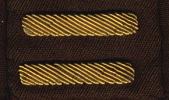
Overseas stripes made of
gold embroidery
|
.v |
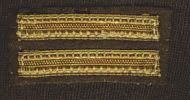
Overseas stripes made of
gold colored braid
|
.
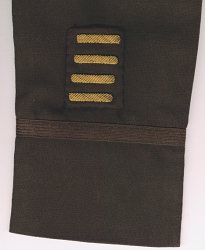
.
Placement of sleeve stripes
above
the sleeve braid
|
|
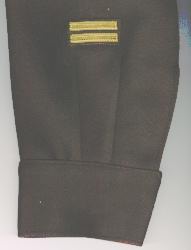
.
Placement of sleeve stripes
on the
wool field jacket (Ike jacket)
|
..
Sleeve Patches
Army Nurses could wear a sleeve patch on their
left upper sleeve of their service and field jacktes, overcoats, utility
coats, raincoats and waists to indicate the Army force to which they were
assigned. The Army was divided in three forces, the Army Service Force,
the Army Air Force and the Army Ground Force. The patch could be that of
a General Headquarters or a special higher-level formation or command.
Army Nurses serving with the Ground Forces were formally assigned at the
level of army groups or armies, but seldom within corps or combat divisions.
To make a complete and accurate survey of all
sleeve patches worn by Army nurses, one would have to possess all the unit
assignment and attachment orders of all nurses during World War II. This
would be an impossible task. Many orders were destroyed or captured by
enemy offenses (i.e., Japanese advance in the Philippines, German counterattacks
at Anzio and the Ardennes, etc.). Furthermore, many orders were destroyed
during the war or accidentally burned during the 1973 loss of personnel
records at the St. Louis depository in postwar America. In other words,
in most cases, the required orders simply no longer exist. http://www.archives.gov/st-louis/military-personnel/fire-1973.html
.
In the following, some examples of United
States Army Sleeve Patches
.
General Headquarters
 .
.
Examples of some headquarters patches
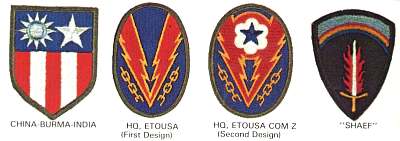
|
.
| China-Burma-India
(CBI) Headquarters: |
. |
The original mission
of the China-Burma-India (CBI) Headquarters was to increase the effectiveness
of U.S. assistance to China and to assist in improving the efficiency of
the Chinese Army. The design of the presented patch had been in use since
1942 but was not officially approved before November 1944. |
| . |
|
|
| ETOUSA
(Headquarters, European Theater of Operations, United States Army): |
|
The ETOUSA
prepared and carried on operations in the ETO against the Axis powers and
their allies under strategical directives of the combined U.S.-British
Chiefs of Staff. After formation of the SHAEF in February 1944 the ETOUSA
became primarily responsible for the administration and supply of
U.S. troops. The first design patch was approved in September 1943. Due
to the change of task a revised design adopting the Army Service Forces
insignia was approved in February 1944. |
| . |
|
|
| SHAEF
(Supreme Headquarters, Allied Expeditionary Force): |
|
The primary
mission of the SHAEF (Supreme Headquarters, Allied Expeditionary Force)
was to enter the continent of Europe and in conjunction with the other
United Nations, undertake operations aimed at Germany and the destruction
of her armed forces. |
.
Air Forces
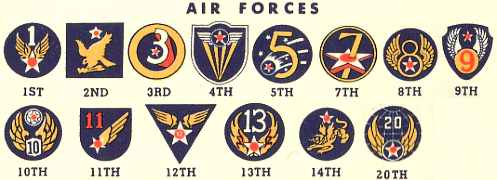
.
Service Commands

.
|
Army Groups

.
Armies of the Ground Forces

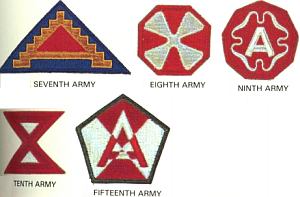 |
(note: there was also a
14th Army, but it was not activated during WWII)
|
|
If you search for more information and more
examples of U.S. Army soulder sleeve insignia take a look at this great
homepage compiled by Dr. Howard G. Lanham: http://www.angelfire.com/md2/patches/branchI.html
|


